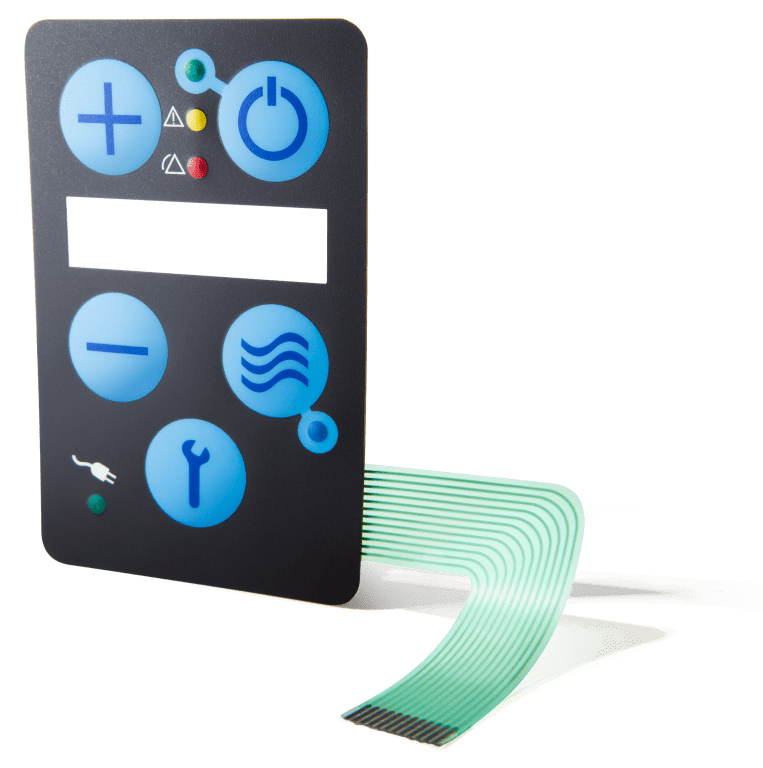Discover Custom Printing and Graphic Overlay Options for Membrane Switches
Discover Custom Printing and Graphic Overlay Options for Membrane Switches
Blog Article
The Ultimate Resource on Membrane Switches: Style, Functionality, and Applications
Membrane changes offer as an interesting junction of layout and functionality, playing a critical role in modern-day interface across different fields. This source unpacks the essential elements that add to their performance, consisting of graphic overlays and circuit traces, while likewise elucidating the mechanisms behind their pressure activation. As we discover the varied applications of membrane layer buttons, it comes to be evident that their adaptability and sturdiness are important in settings ranging from healthcare to customer electronic devices. Nevertheless, the subtleties of their design and functional concepts may expose also deeper insights worth taking into consideration.

Understanding Membrane Layer Buttons
Membrane buttons are a type of interface technology commonly used in different electronic devices, identified by their thin, versatile layout and functionality. These switches include several layers that include visuals overlays, sticky layers, and wiring, allowing a compact and reliable user interface for customers. They can be discovered in appliances, medical gadgets, and commercial control board, providing a dependable technique for customer interaction.
Among the key advantages of membrane switches is their capability to stand up to contaminants such as dust and moisture, making them ideal for environments where longevity is important. Their low-profile layout permits seamless combination into various applications, while the personalized visuals overlays enhance individual experience by giving clear aesthetic comments. Furthermore, membrane switches can fit a range of modern technologies, such as tactile responses and backlighting, more boosting their usability.
The production procedure for membrane switches over typically involves display die-cutting, lamination, and printing strategies, guaranteeing precision and uniformity in manufacturing. In general, membrane changes represent a reliable and functional option for modern digital gadgets, incorporating capability with aesthetic appeal in customer interface style.
Secret Components and Layout Aspects
A selection of key parts and style components integrated to produce an efficient membrane button. At the core, the graphic overlay serves both aesthetic and useful functions, using an user-friendly interface while securing internal parts from ecological variables. The choice of materials, normally polyester or polycarbonate, influences resilience and responsive responses.
Underneath the overlay, the sticky layer makes sure the button adheres securely to the substrate, which can be plastic, glass, or steel. The spacer layer is important, as it preserves the required gap between the overlay and the circuit layers, allowing for reliable actuation. Membrane Switches. Circuit traces, usually made from conductive ink or adhesive, are printed on an adaptable substrate, allowing electrical signals to be transmitted when pressure is used
Style considerations additionally consist of the plan of tactile domes or embossing that give physical feedback to the individual, enhancing the overall experience. In addition, the layout and spacing of the switches need to be maximized for convenience of use, making sure that customers can browse the user interface with ease. On the whole, these parts and style components work synergistically to produce a reputable, practical membrane layer button tailored to specific applications.
Capability and Operation Mechanism
At the heart of efficient capability for membrane layer switches exists their functional device, which helps with customer communication through an easy yet efficient layout. These switches operate the concept of pressure activation, where an individual applies pressure to an assigned area of the switch (Membrane Switches). This action compresses the layers of the switch, finishing an electric circuit that sends a signal to the connected tool
The construction generally includes a leading graphic layer, an adhesive spacer layer, and a lower circuit layer, which jointly form a durable interface. When pressure is applied, the leading layer falls down versus the lower circuit layer, enabling conductive traces to link. This style not only allows clear tactile comments yet also makes sure toughness and dependability, as the switches are often immune to dust and dampness.
Furthermore, the adaptability of membrane layer changes enables assimilation with numerous technologies, consisting of LED indications and microcontrollers, improving their capability. By giving a structured interface that decreases mechanical wear, membrane layer changes stay a favored choice in applications varying from consumer electronics to industrial equipment, making sure ideal efficiency and customer complete satisfaction throughout diverse settings.
Types of Membrane Buttons

An additional substantial group is brightened membrane buttons, which include backlighting to enhance exposure in low-light conditions. These buttons are usually made use of in control panels and control panels where clear exposure is necessary.
Furthermore, there are custom membrane layer switches created to meet specific dimensional, graphical, and functional demands. These customizations can my site include unique shapes, colors, and designs, permitting smooth combination right into different tools.

Applications Throughout Different Industries
Just how do membrane layer buttons enhance functionality throughout varied markets? In the clinical industry, membrane buttons play a crucial role in devices such as analysis tools and person tracking systems, where reliability and ease of cleansing are vital.
In the vehicle sector, membrane layer buttons are generally made use of in dashboards and control board, offering user-friendly controls that improve vehicle driver safety and security and benefit. The consumer electronic devices industry also takes advantage of their customizable and lightweight attributes, enabling streamlined styles for smart devices and home appliances.
In addition, membrane layer buttons find applications in commercial automation, where they add to efficient machinery procedure and tracking systems. Their resistance to dust and moisture ensures performance sought after problems (Membrane Switches). In addition, the food and beverage industry utilizes membrane switches for equipment control, where hygiene and durability are crucial
Conclusion
In verdict, membrane layer switches over represent an essential technology in individual interface technology, identified by their unique design and capability. The flexibility of membrane changes facilitates their application across varied markets, from clinical gadgets to customer electronics.
Membrane layer changes offer as a fascinating junction of design and performance, playing an essential function in modern-day user interfaces across numerous industries.Membrane layer switches are a type of individual interface technology extensively utilized in numerous electronic gadgets, identified by their slim, versatile layout and capability.At the heart of effective performance for membrane switches lies their operational device, which assists in customer interaction via a basic yet reliable design. These buttons run on the principle of pressure activation, where a customer applies force to an assigned location of find here the switch.In final thought, membrane layer switches represent a crucial advancement in customer interface innovation, identified by their unique design and capability.
Report this page